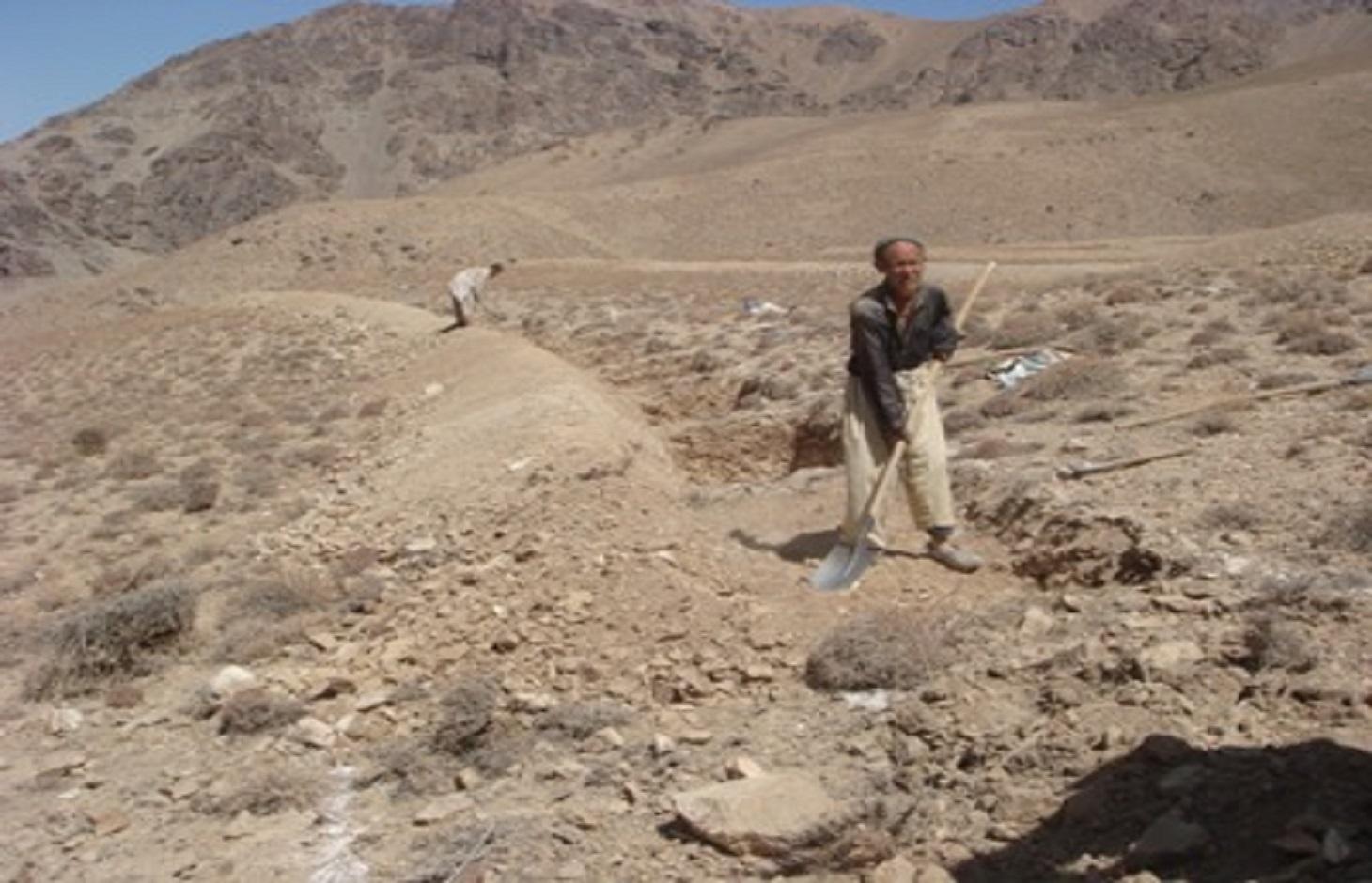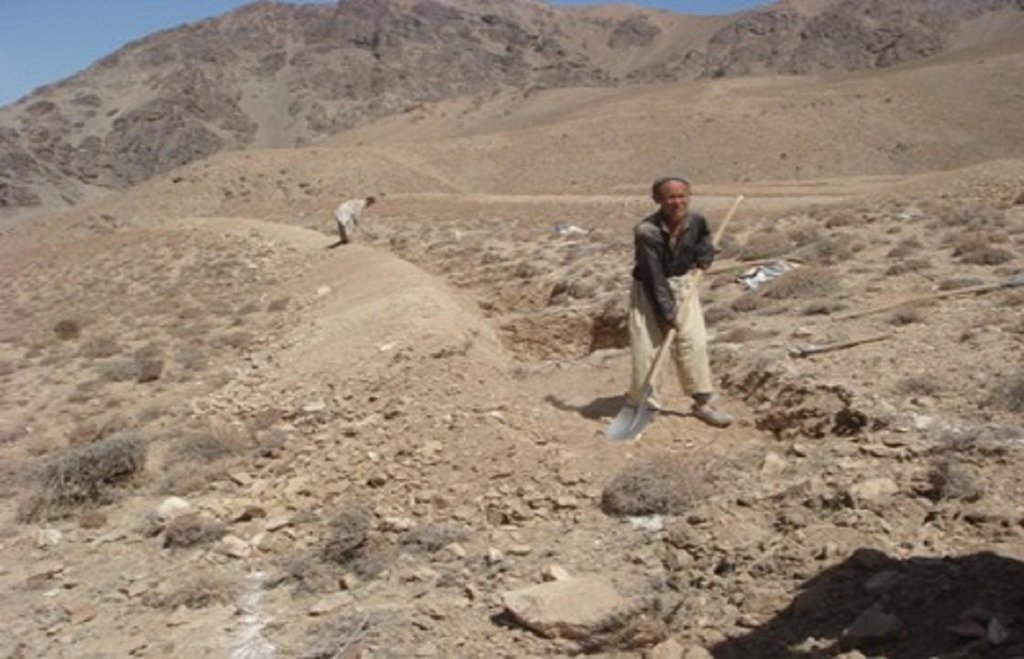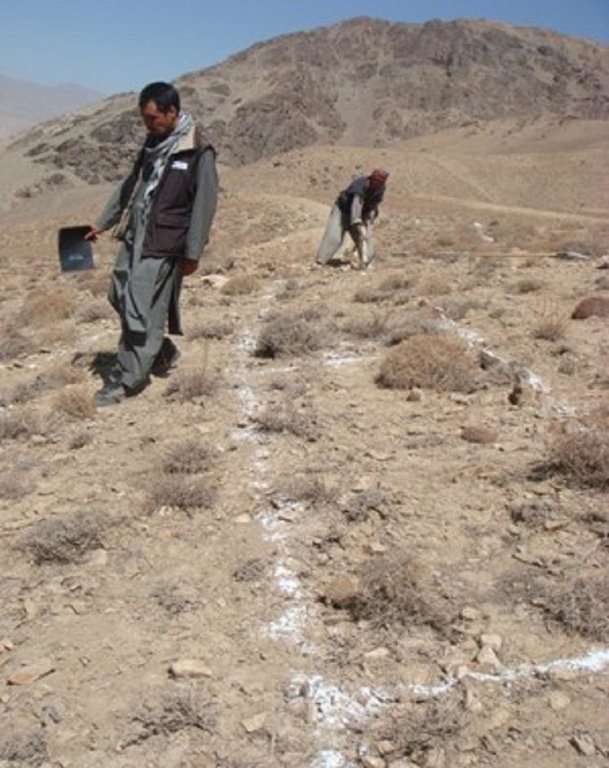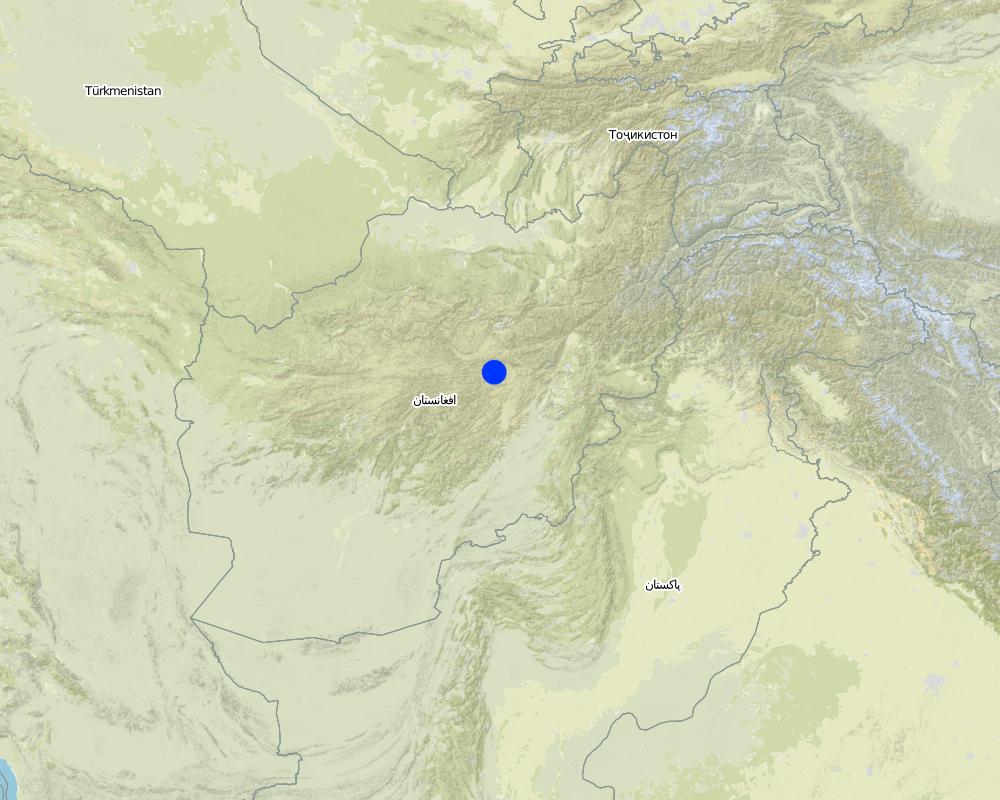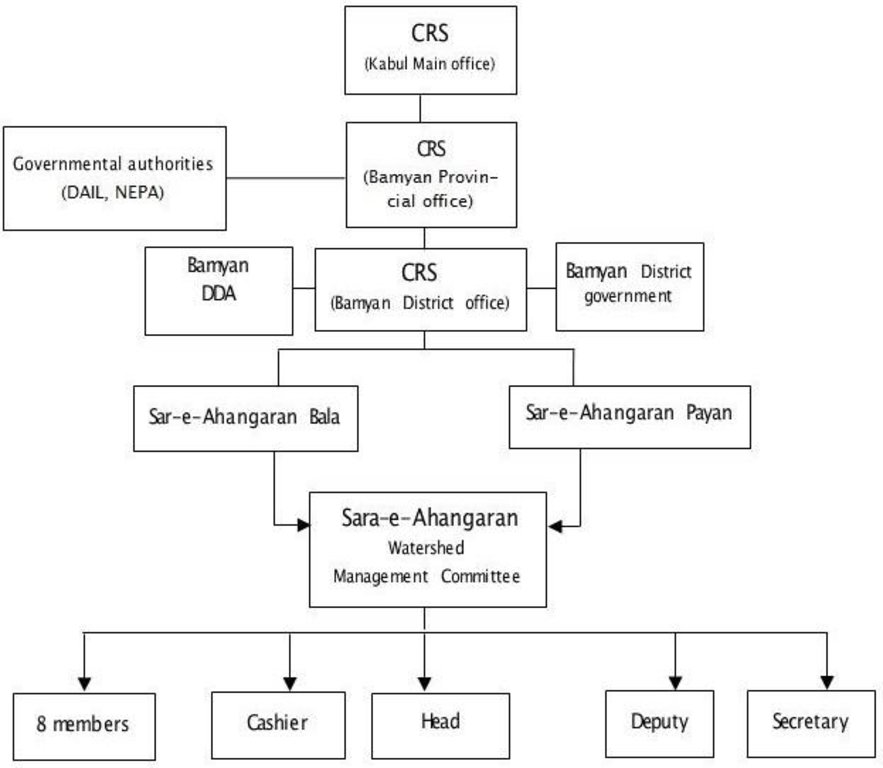Community-Based Watershed Management [أفغانستان]
- تاريخ الإنشاء:
- تحديث:
- جامع المعلومات: Aqila Haidery
- المحرر: –
- المُراجع: Deborah Niggli
Mudiriat Aabreza Tawasut Mardum (Dari)
approaches_2612 - أفغانستان
عرض الأقسام
توسيع الكل طي الكل1. معلومات عامة
1.2 تفاصيل الاتصال بالأشخاص الرئيسيين لمصدر المعلومات والمؤسسات المعنية بتقييم وتوثيق النهج
متخصص في الإدارة المستدامة للأراضي:
متخصص في الإدارة المستدامة للأراضي:
متخصص في الإدارة المستدامة للأراضي:
Montzieux Mathilde
أفغانستان
متخصص في الإدارة المستدامة للأراضي:
Hazem Zainullah
أفغانستان
متخصص في الإدارة المستدامة للأراضي:
Alemi Saadat
أفغانستان
متخصص في الإدارة المستدامة للأراضي:
Ershad Mustafa
أفغانستان
متخصص في الإدارة المستدامة للأراضي:
Ahmadi Reza
أفغانستان
اسم المؤسسة (المؤسسات) التي سهلت توثيق/تقييم النهج (إذا كان ذلك على صلة)
HELVETAS (Swiss Intercooperation)1.3 الشروط المتعلقة باستخدام البيانات الموثقة من خلال WOCAT
متى تم تجميع البيانات (ميدانيا)؟:
10/11/2011
يوافق جامع المعلومات والشخص (لاشخاص) الرئيسي لمصدر المعلومات على الشروط المتعلقة باستخدام البيانات الموثقة من خلال WOCAT:
نعم
1.4 المراجع الخاصة باستبيان(استبيانات) تقنيات الإدارة المستدامة للأراضي

Stone wall [أفغانستان]
Contour stone walls constructed on moderate to steep slopes to retain water and sediments and trap snow.
- جامع المعلومات: Aqila Haidery
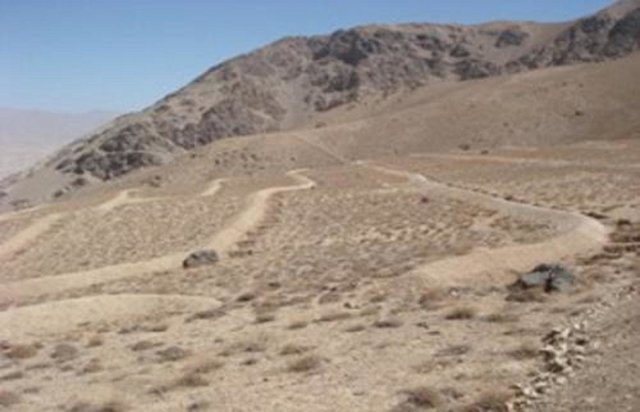
Contour Trench Bund [أفغانستان]
Contour trench bund applied on contour lines of moderate slope to trap run-off to improve infiltration and reduce flash floods.
- جامع المعلومات: Aqila Haidery
2. وصف نهج الإدارة المستدامة للأراضي
2.1 وصف موجز للنهج
Sustainable implementation of watershed management through appropriate SLM technologies, formation of organizational structures and capacity building of stakeholders
2.2 وصف تفصيلي للنهج
وصف تفصيلي للنهج:
The overall objective of the community-based watershed management project implemented at Sar-e-Ahangaran was to reduce water induced disaster risks and improve people’s livelihoods. The project was implemented by Catholic Relief Services (CRS) with people’s support and funding assistance from USAID.
About 67 hectares of degraded land has been rehabilitated since 2009 through various soil and water conservation measures like stone walls, contour trenches and plantation of fodder species such as alfalfa. The local communities are also protecting the treated areas from grazing and shrub cutting.
With facilitation from CRS, a 15-member watershed management committee was appointed by the participating families. This was important for organizing watershed related works and for the sustainability of project interventions. Some rules for managing the selected watershed were also formulated in a participatory way. For instance, if anyone is found grazing animals at the site, he has to give one sheep to the watershed committee as a fine.
CRS has provided training and technical support to the watershed committee members and workers for project implementation and monitoring. The daily workers were selected from the local communities by the watershed committee and paid in cash as per national norms for their labor. CRS also organized awareness raising workshops regarding environmental conservation and water-shed management and the entire community including teachers and students participated in these village events.
As a result of Sar-e-Ahangaran watershed management project, the people have a more positive attitude towards natural resource management. The formation and capacity building of the watershed management committee is a step towards ensuring long-term sustainability of the project outputs and community owner-ship. The watershed committee is not yet registered with the government but for future sustainability, this will be an important activity. The Islamic Republic of Afghanistan is in the process of formulating a comprehensive community-based natural resource management strategy. Once in place, the Sar-e-Ahangaran community can take advantage of that strategy if the watershed committee is formally registered with the Ministry of Agriculture, Irrigation and Livestock (Bamyan).
The Community-Based Watershed Management approach is documented by Sustainable Land Management Project /HELVETAS Swiss Intercooperation which is funded by Swiss Agency for Development and Cooperation with close support and cooperation of the Catholic Relief Service (CRS).
2.3 صور عن النهج
2.5 البلد/المنطقة/المواقع التي تم تطبيق النهج فيها
البلد:
أفغانستان
المنطقة/الولاية/المحافظة:
Bamyan
مزيد من التفاصيل حول الموقع:
Sar-e-Ahangaran, Bamyan center
Map
×2.6 تواريخ بدء وإنهاء تنفيذ النهج
أشر إلى سنة البدء:
2009
2.7 نوع النهج
- قائم على مشروع/برنامج
2.8 الغايات/الأهداف الرئيسية للنهج
The Approach focused mainly on SLM with other activities (Disaster Risk Reduction, Rural Livelihoods Improvement)
The overall objective of the project was to reduce watershed induced disaster risks and improve rural livelihoods through SLM technologies and community based sustainable approaches
The SLM Approach addressed the following problems: Lack of people’s knowledge regarding sustainable management of natural resources and disaster risk reduction, lack of knowledge, technical and organisational capacities on sustainable land management technologies for degraded lands
2.9 الظروف التي تمكن أو تعيق تنفيذ التقنية/التقنيات المطبقة بموجب النهج
المعايير والقيم الاجتماعية /الثقافية/ الدينية
- معيق
People did not have a good idea about how to conserve the environment and at the same time reduce disaster risks and improve their livelihoods
Treatment through the SLM Approach: Training and education via sharing knowledge with watershed committees in Waras forming maintenance committees who should look after restrictions about grazing. Practical demonstration of potential SLM technologies
توفر/الوصول إلى الموارد والخدمات المالية
- معيق
People do not have financial capacities
Treatment through the SLM Approach: Project had a Cash for Work but learning approach
الإطار القانوني (حيازة الأراضي، وحقوق استخدام الأراضي والمياه)
- معيق
As the land is formally owned by the government, people did not invest much in sustainable practices. During project initiation, people were also sceptical and rejected the project idea as they thought that by digging trenches, the project was trying to search for gold
Treatment through the SLM Approach: Through several discussions and clarifications and by assurances from the government, people were convinced that the project had no hidden motives and gradually their trust in CRS increased
المعرفة حول الإدارة المستدامة للأراضي، والوصول إلى الدعم الفني
- معيق
Lack of knowledge about SLM measures
Treatment through the SLM Approach: Training and technical support from CRS
3. المشاركة وأدوار الأطراف المعنية
3.1 أصحاب المصلحة المعنيون بالنهج وأدوارهم
- مستخدمو الأراضي المحليون/المجتمعات المحلية
- المنظمات المجتمعية
3.2 انخراط مستخدمي الأراضي المحليين/المجتمعات المحلية في المراحل المختلفة للنهج
| انخراط مستخدمي الأراضي المحليين/المجتمعات المحلية | حدد من شارك وصف الأنشطة | |
|---|---|---|
| المبادرة/التحفيز | تفاعلي | CRS discussed land use problems and formulated the project. Project site was selected by the participating families and respective CDCs |
| التخطيط | تفاعلي | CDC and watershed members were involved in the planning but not the whole community |
| التنفيذ | الدعم الخارجي | Implementation was by the local communities with cash for work approach |
| الرصد/التقييم | التعبئة الذاتية | Voluntary monitoring group to look after the environment. Also joint monitoring by project stakeholders |
| Research | سلبي |
3.3 مخطط التدفق (إذا كان متاحًا)
الوصف:
The organizational Chart of Sar-e_Ahangaran Watershed Management Committee
المؤلف:
Catholic Relief Service (CRS)
3.4 اتخاذ القرار بشأن اختيار تقنية/تقنيات الإدارة المستدامة للأراضي
حدد من الذي قرر اختيار التقنية/التقنيات التي سيتم تنفيذها:
- متخصصون في الإدارة المستدامة للأراضي بشكل أساسي، بعد التشاور مع مستخدمي الأراضي
اشرح:
The area was selected by the community
Decisions on the method of implementing the SLM Technology were made by mainly by SLM specialists with consultation of land users. However, workers were selected by the watershed committee members in consultation with their community development councils (CDCs).
4. الدعم الفني وبناء القدرات وإدارة المعرفة
4.1 بناء القدرات/التدريب
هل تم تقديم التدريب لمستخدمي الأراضي / الأطراف المعنيين الآخرين؟:
نعم
حدد من تم تدريبه:
- مستخدمو الأراضي
- Project field officers, Land users, CDC and Watershed Management Committee members, teacher and students, both women and men
شكل التدريب:
- في العمل
- من مزارع إلى مزارع
شكل التدريب:
- organizing courses
المواضيع المغطاة:
contour trench and stone wall technologies, tree planting, importance of pasture management and watershed management
4.2 خدمة استشارية
هل يملك مستخدمو الأراضي وصولا إلى خدمة استشارية؟:
نعم
وصف/تعليقات:
CRS provided continuous advice; Key elements: increase awareness by forming a watershed committee, technical support of the committee
Advisory service is inadequate to ensure the continuation of land conservation activities; The government or other advisory service is still inadequate to ensure the continuation of land conservation activities. The government authorities visited the project only once, at the end of the project. They did not provide much support; however, as the land belongs formally to the state, they did not have any objections for applying watershed management measures.
4.3 تعزيز المؤسسات (التطوير التنظيمي)
هل تم إنشاء أو تعزيز مؤسسات من خلال هذا النهج؟:
- نعم، باعتدال
حدد المستوى (المستويات) التي تم فيها تعزيز أو إنشاء المؤسسات:
- محلي
اعط مزيدا من التفاصيل:
CDCs and watershed management committees. Schools teachers and students also received training
4.4 الرصد والتقييم
هل يشكل الرصد والتقييم جزءا من النهج؟:
نعم
التعليقات:
bio-physical aspects were regular monitored by project staff through measurements; indicators: Water quality and quantitative measurements
technical aspects were ad hoc monitored by project staff, land users, other through observations; indicators: ad hoc field visits and monitoring of structural quality
socio-cultural aspects were ad hoc monitored by project staff through measurements; indicators: Hosuehold survey
economic / production aspects were ad hoc monitored by project staff through measurements; indicators: Household survey
area treated aspects were ad hoc monitored by project staff through observations; indicators: Other areas where technology has been applied
no. of land users involved aspects were regular monitored by land users through measurements; indicators: Selecting the beneficiaries
management of Approach aspects were None monitored by land users through observations; indicators: Monitoring the community which looks after the pasture management
There were few changes in the Approach as a result of monitoring and evaluation: especially with regard to organisational structure for monitoring works
4.5 البحوث
هل كانت البحوث جزءًا من النهج؟:
نعم
- Farm research
أعط تفاصيل إضافية وأشر إلى من قام بالبحوث:
Topics included technology functions, vegetation status before and after project, monitoring of spring (located below) water quality and quantity.
5. التمويل والدعم المادي الخارجي
5.1 الميزانية السنوية لمكون الإدارة المستدامة للأراضي في النهج المذكور
إذا لم تكن الميزانية السنوية الدقيقة معروفة، قم بالإشارة إلى نطاقها:
- 100,000-10,000
التعليقات (على سبيل المثال المصادر الرئيسية للتمويل/الجهات المانحة الرئيسية):
Approach costs were met by the following donors: international non-government: 99.0%; local community / land user(s): 1.0%
5.2 الدعم المالي/المادي المقدم لمستخدمي الأراضي
هل حصل مستخدمو الأراضي على دعم مالي/ مادي لتنفيذ التقنية/ التقنيات؟:
كلا
5.4 الائتمان
هل تم توفير ائتمان في إطار نهج أنشطة الإدارة المستدامة للأراضي؟:
كلا
5.5 حوافز أو وسائل أخرى
هل تم استخدام حوافز أو أدوات أخرى لتشجيع تنفيذ تقنيات الإدارة المستدامة للأراضي؟:
كلا
6. تحليل الأثر والتصريحات الختامية
6.1 آثار النهج
هل ساعد النهج مستخدمي الأراضي على تنفيذ وصيانة تقنيات الإدارة المستدامة للأراضي؟:
- لا
- نعم، قليلا
- نعم، باعتدال
- نعم، إلى حد كبير
Land cover by vegetation improved significantly. Flash floods and snow avalanche problems were reduced, and the community members were more aware about the technologies and approaches for sustainable land management.
هل ساهم النهج في تمكين الفئات المحرومة اجتماعيا واقتصاديا؟:
- لا
- نعم، قليلا
- نعم، باعتدال
- نعم، إلى حد كبير
People got cash for work and some of the families could pay back their loans through this income.
The land belongs to the state and the water use right is as well open access and and organized manner. In this particular land land use problem or water use problems have not been seen.
Did other land users / projects adopt the Approach?
- لا
- نعم، قليلا
- نعم، باعتدال
- نعم، إلى حد كبير
There were constraints from the people in the beginning. Now a similar approach with some modifications is being implemented in other watersheds as well as a result of this project.
Did the Approach lead to improved livelihoods / human well-being?
- لا
- نعم، قليلا
- نعم، باعتدال
- نعم، إلى حد كبير
They got more money via the cash for work; however, there is no impact for the livestock because the pasture area is big enough.
Did the Approach help to alleviate poverty?
- لا
- نعم، قليلا
- نعم، باعتدال
- نعم، إلى حد كبير
due to cash for work approach and increased production of wheat, potato and other agricultural products as a result of reduced flood risks
6.2 المحفز الرئيسي لقيام مستخدمي الأراضي بتنفيذ الإدارة المستدامة للأراضي
- زيادة الربح (القدرة)، وتحسين نسبة التكلفة إلى العائد
- القواعد واللوائح (الغرامات) / الإنفاذ
- to get employed through cash for work
- reduce flood risks
- Understand the importance of watershed
- Understand the importance of NRM
- Ownership of the project activities
6.3 استدامة أنشطة النهج
هل يمكن لمستخدمي الأراضي المحافظة على استدامة ما تم تنفيذه من خلال النهج (بدون دعم خارجي)؟:
- غير مؤكد
إذا كان الجواب لا أو غير متأكد، حدد ذلك وعلق عليه:
but CRS continues to build capacities of watershed committees and support plantation of fodder species so that people get direct benefits and the project is sustained.
6.4 نقاط قوة/مزايا النهج
| نقاط القوة/ المزايا/ الفرص من وجهة نظر جامع المعلومات أو غيره من الاشخاص الرئيسيين لمصدر المعلومات |
|---|
| Less damage to some agricultural land located below the watershed sites due to flash floods |
| Prevention of snow slide |
| Increased water in the spring |
| Plant coverage of the area increased |
| Prevention from soil erosion |
6.5 نقاط الضعف/ العيوب في المنهج وطرق التغلب عليها
| نقاط الضعف/ المساوىء/ المخاطر من وجهة نظر جامع المعلومات أو غيره من الاشخاص الرئيسيين لمصدر المعلومات | كيف يمكن التغلب عليها؟ |
|---|---|
| Watershed management committee is not registered | CRS should facilitate registration of the committee with the Department of Agriculture, Irrigation and Livestock in Bamyan |
| People are not taking care of the plantations | People must understand the importance of plantations. The project should figure out the reasons why people are not interested in plantation activities and adjust approaches accordingly |
7. المراجع والروابط
7.1 طرق جمع/مصادر المعلومات
- زيارات ميدانية، مسوحات ميدانية
- مقابلات مع مستخدمي الأراضي
الروابط والوحدات المواضيعية
توسيع الكل طي الكلالروابط

Stone wall [أفغانستان]
Contour stone walls constructed on moderate to steep slopes to retain water and sediments and trap snow.
- جامع المعلومات: Aqila Haidery

Contour Trench Bund [أفغانستان]
Contour trench bund applied on contour lines of moderate slope to trap run-off to improve infiltration and reduce flash floods.
- جامع المعلومات: Aqila Haidery
الوحدات المواضيعية
لا يوجد وحدات مواضيعية


